Nurses' Role in Addressing Violence
VerifiedAdded on 2020/04/07
|9
|2290
|397
AI Summary
This assignment delves into the significant role nurses play in providing care to individuals who have experienced violence or abuse. It highlights the importance of nurses recognizing and responding to these situations, ensuring patient safety and well-being. The document emphasizes the ethical and legal responsibilities nurses hold regarding reporting suspected cases of violence and creating safe environments for patients and their families. The text also discusses the need for adequate training and resources to equip nurses effectively in handling such sensitive situations.
Contribute Materials
Your contribution can guide someone’s learning journey. Share your
documents today.
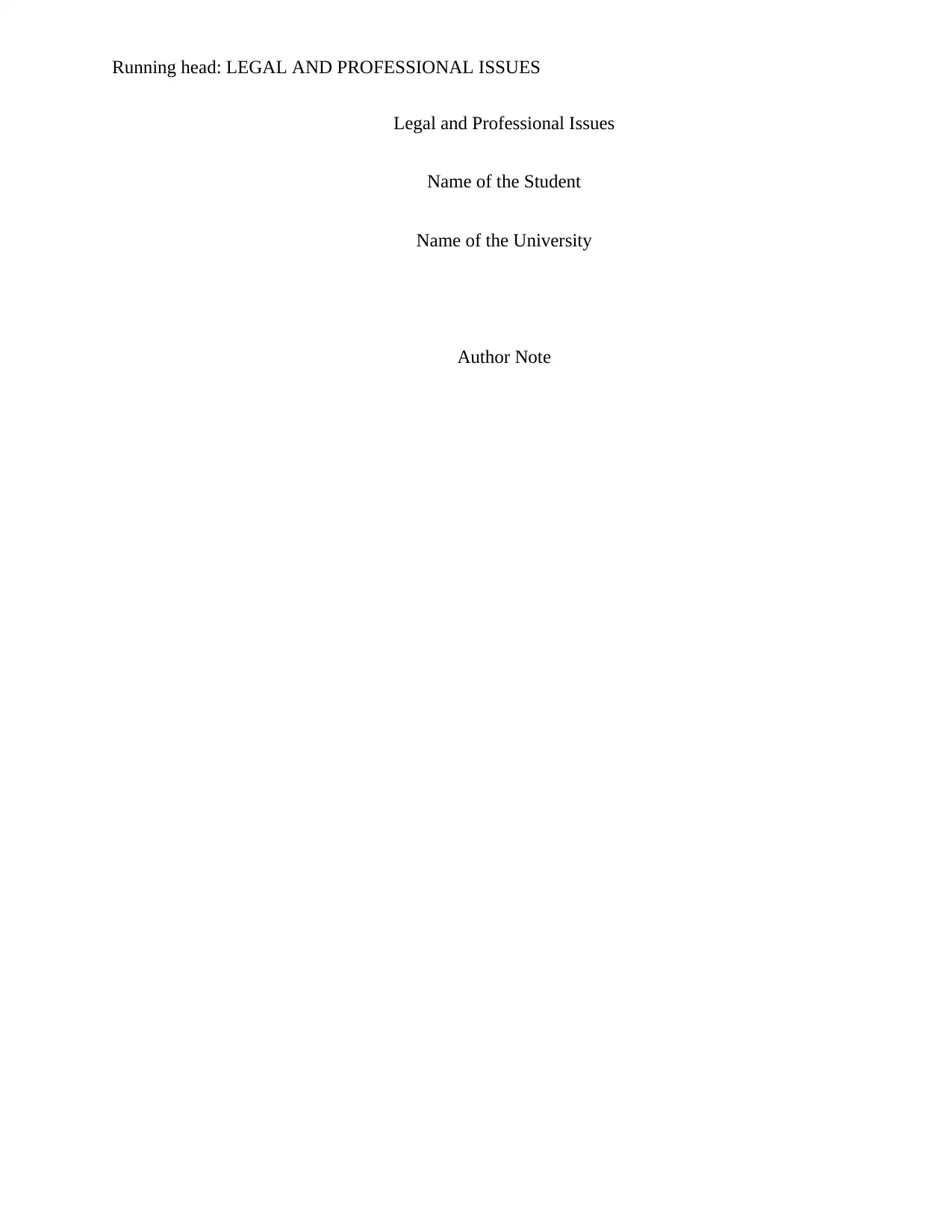
Running head: LEGAL AND PROFESSIONAL ISSUES
Legal and Professional Issues
Name of the Student
Name of the University
Author Note
Legal and Professional Issues
Name of the Student
Name of the University
Author Note
Secure Best Marks with AI Grader
Need help grading? Try our AI Grader for instant feedback on your assignments.
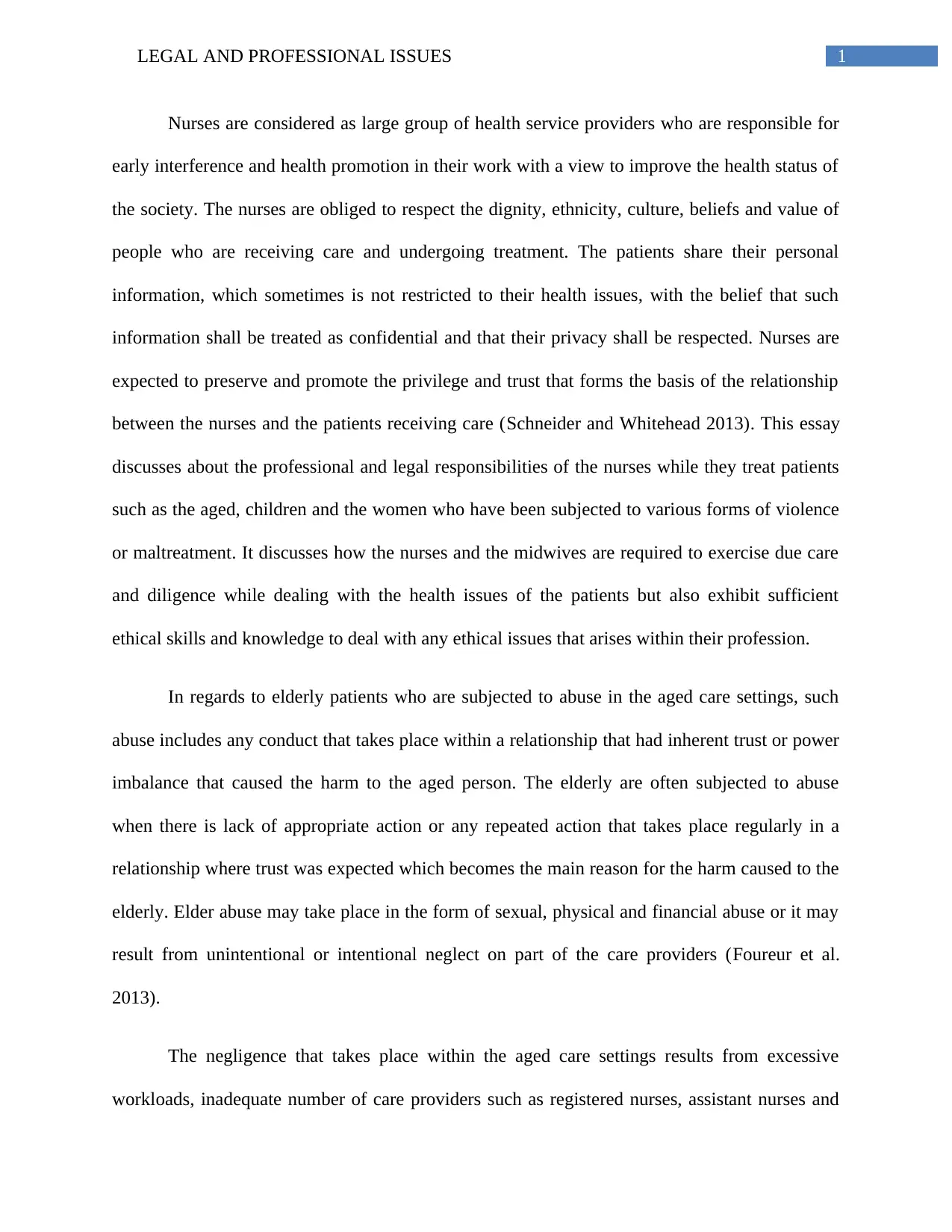
1LEGAL AND PROFESSIONAL ISSUES
Nurses are considered as large group of health service providers who are responsible for
early interference and health promotion in their work with a view to improve the health status of
the society. The nurses are obliged to respect the dignity, ethnicity, culture, beliefs and value of
people who are receiving care and undergoing treatment. The patients share their personal
information, which sometimes is not restricted to their health issues, with the belief that such
information shall be treated as confidential and that their privacy shall be respected. Nurses are
expected to preserve and promote the privilege and trust that forms the basis of the relationship
between the nurses and the patients receiving care (Schneider and Whitehead 2013). This essay
discusses about the professional and legal responsibilities of the nurses while they treat patients
such as the aged, children and the women who have been subjected to various forms of violence
or maltreatment. It discusses how the nurses and the midwives are required to exercise due care
and diligence while dealing with the health issues of the patients but also exhibit sufficient
ethical skills and knowledge to deal with any ethical issues that arises within their profession.
In regards to elderly patients who are subjected to abuse in the aged care settings, such
abuse includes any conduct that takes place within a relationship that had inherent trust or power
imbalance that caused the harm to the aged person. The elderly are often subjected to abuse
when there is lack of appropriate action or any repeated action that takes place regularly in a
relationship where trust was expected which becomes the main reason for the harm caused to the
elderly. Elder abuse may take place in the form of sexual, physical and financial abuse or it may
result from unintentional or intentional neglect on part of the care providers (Foureur et al.
2013).
The negligence that takes place within the aged care settings results from excessive
workloads, inadequate number of care providers such as registered nurses, assistant nurses and
Nurses are considered as large group of health service providers who are responsible for
early interference and health promotion in their work with a view to improve the health status of
the society. The nurses are obliged to respect the dignity, ethnicity, culture, beliefs and value of
people who are receiving care and undergoing treatment. The patients share their personal
information, which sometimes is not restricted to their health issues, with the belief that such
information shall be treated as confidential and that their privacy shall be respected. Nurses are
expected to preserve and promote the privilege and trust that forms the basis of the relationship
between the nurses and the patients receiving care (Schneider and Whitehead 2013). This essay
discusses about the professional and legal responsibilities of the nurses while they treat patients
such as the aged, children and the women who have been subjected to various forms of violence
or maltreatment. It discusses how the nurses and the midwives are required to exercise due care
and diligence while dealing with the health issues of the patients but also exhibit sufficient
ethical skills and knowledge to deal with any ethical issues that arises within their profession.
In regards to elderly patients who are subjected to abuse in the aged care settings, such
abuse includes any conduct that takes place within a relationship that had inherent trust or power
imbalance that caused the harm to the aged person. The elderly are often subjected to abuse
when there is lack of appropriate action or any repeated action that takes place regularly in a
relationship where trust was expected which becomes the main reason for the harm caused to the
elderly. Elder abuse may take place in the form of sexual, physical and financial abuse or it may
result from unintentional or intentional neglect on part of the care providers (Foureur et al.
2013).
The negligence that takes place within the aged care settings results from excessive
workloads, inadequate number of care providers such as registered nurses, assistant nurses and
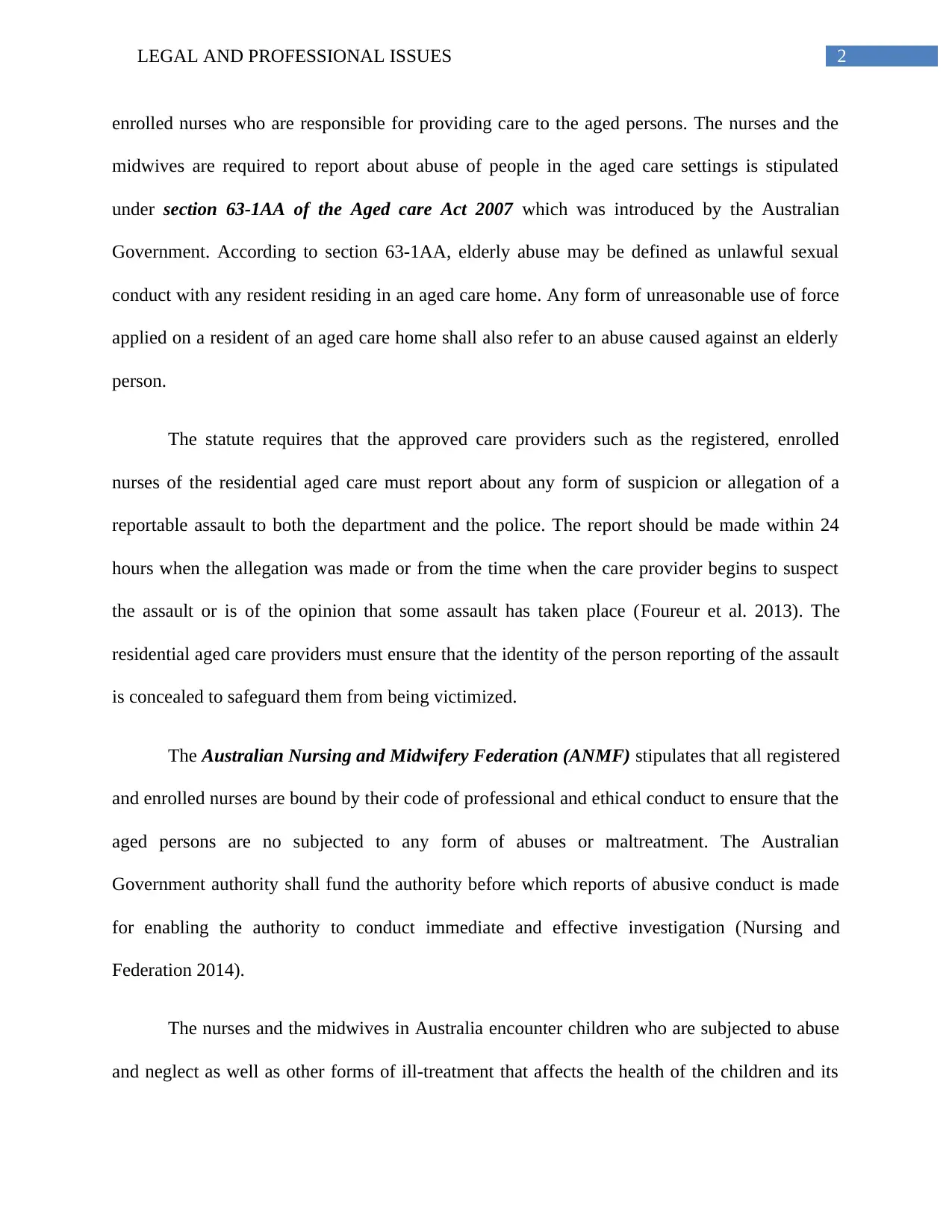
2LEGAL AND PROFESSIONAL ISSUES
enrolled nurses who are responsible for providing care to the aged persons. The nurses and the
midwives are required to report about abuse of people in the aged care settings is stipulated
under section 63-1AA of the Aged care Act 2007 which was introduced by the Australian
Government. According to section 63-1AA, elderly abuse may be defined as unlawful sexual
conduct with any resident residing in an aged care home. Any form of unreasonable use of force
applied on a resident of an aged care home shall also refer to an abuse caused against an elderly
person.
The statute requires that the approved care providers such as the registered, enrolled
nurses of the residential aged care must report about any form of suspicion or allegation of a
reportable assault to both the department and the police. The report should be made within 24
hours when the allegation was made or from the time when the care provider begins to suspect
the assault or is of the opinion that some assault has taken place (Foureur et al. 2013). The
residential aged care providers must ensure that the identity of the person reporting of the assault
is concealed to safeguard them from being victimized.
The Australian Nursing and Midwifery Federation (ANMF) stipulates that all registered
and enrolled nurses are bound by their code of professional and ethical conduct to ensure that the
aged persons are no subjected to any form of abuses or maltreatment. The Australian
Government authority shall fund the authority before which reports of abusive conduct is made
for enabling the authority to conduct immediate and effective investigation (Nursing and
Federation 2014).
The nurses and the midwives in Australia encounter children who are subjected to abuse
and neglect as well as other forms of ill-treatment that affects the health of the children and its
enrolled nurses who are responsible for providing care to the aged persons. The nurses and the
midwives are required to report about abuse of people in the aged care settings is stipulated
under section 63-1AA of the Aged care Act 2007 which was introduced by the Australian
Government. According to section 63-1AA, elderly abuse may be defined as unlawful sexual
conduct with any resident residing in an aged care home. Any form of unreasonable use of force
applied on a resident of an aged care home shall also refer to an abuse caused against an elderly
person.
The statute requires that the approved care providers such as the registered, enrolled
nurses of the residential aged care must report about any form of suspicion or allegation of a
reportable assault to both the department and the police. The report should be made within 24
hours when the allegation was made or from the time when the care provider begins to suspect
the assault or is of the opinion that some assault has taken place (Foureur et al. 2013). The
residential aged care providers must ensure that the identity of the person reporting of the assault
is concealed to safeguard them from being victimized.
The Australian Nursing and Midwifery Federation (ANMF) stipulates that all registered
and enrolled nurses are bound by their code of professional and ethical conduct to ensure that the
aged persons are no subjected to any form of abuses or maltreatment. The Australian
Government authority shall fund the authority before which reports of abusive conduct is made
for enabling the authority to conduct immediate and effective investigation (Nursing and
Federation 2014).
The nurses and the midwives in Australia encounter children who are subjected to abuse
and neglect as well as other forms of ill-treatment that affects the health of the children and its
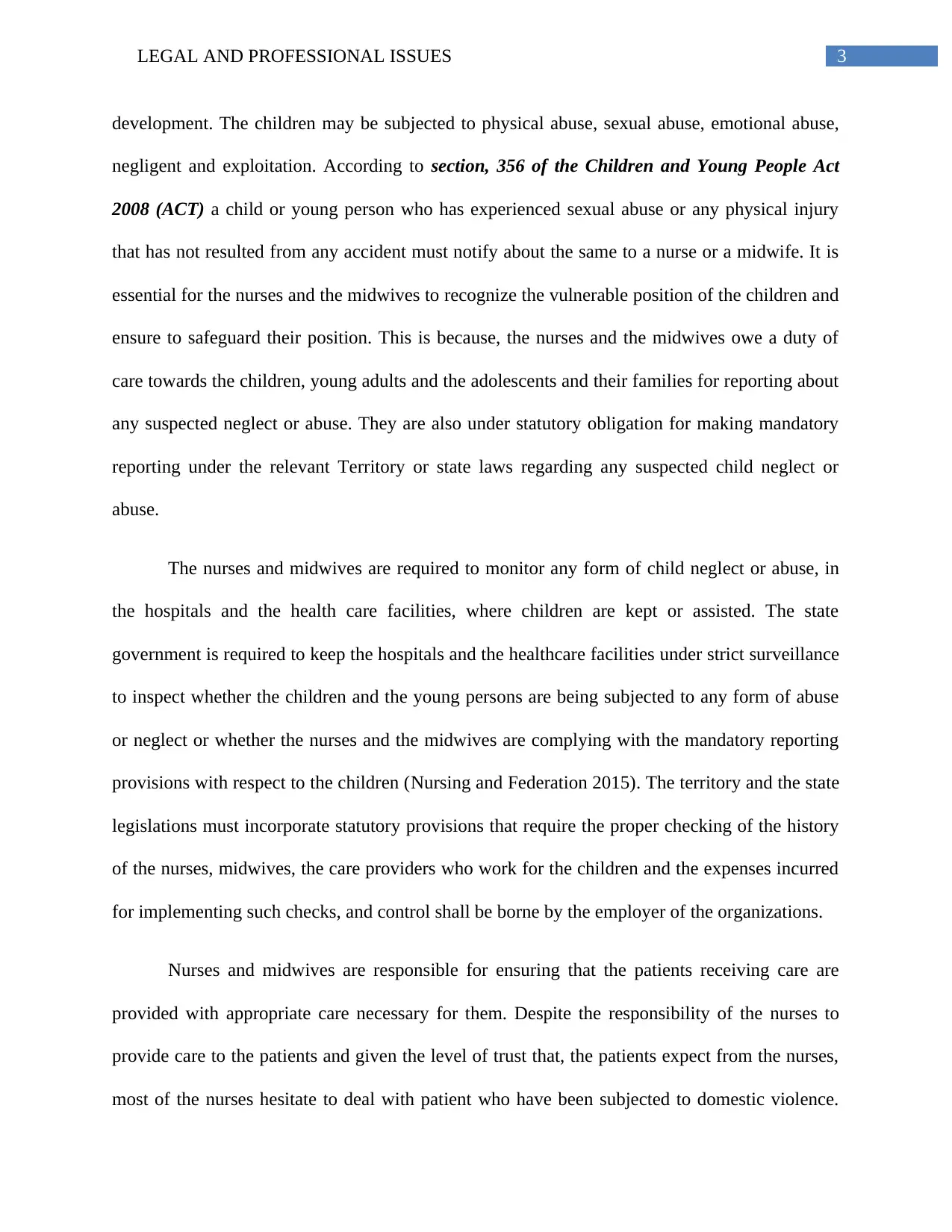
3LEGAL AND PROFESSIONAL ISSUES
development. The children may be subjected to physical abuse, sexual abuse, emotional abuse,
negligent and exploitation. According to section, 356 of the Children and Young People Act
2008 (ACT) a child or young person who has experienced sexual abuse or any physical injury
that has not resulted from any accident must notify about the same to a nurse or a midwife. It is
essential for the nurses and the midwives to recognize the vulnerable position of the children and
ensure to safeguard their position. This is because, the nurses and the midwives owe a duty of
care towards the children, young adults and the adolescents and their families for reporting about
any suspected neglect or abuse. They are also under statutory obligation for making mandatory
reporting under the relevant Territory or state laws regarding any suspected child neglect or
abuse.
The nurses and midwives are required to monitor any form of child neglect or abuse, in
the hospitals and the health care facilities, where children are kept or assisted. The state
government is required to keep the hospitals and the healthcare facilities under strict surveillance
to inspect whether the children and the young persons are being subjected to any form of abuse
or neglect or whether the nurses and the midwives are complying with the mandatory reporting
provisions with respect to the children (Nursing and Federation 2015). The territory and the state
legislations must incorporate statutory provisions that require the proper checking of the history
of the nurses, midwives, the care providers who work for the children and the expenses incurred
for implementing such checks, and control shall be borne by the employer of the organizations.
Nurses and midwives are responsible for ensuring that the patients receiving care are
provided with appropriate care necessary for them. Despite the responsibility of the nurses to
provide care to the patients and given the level of trust that, the patients expect from the nurses,
most of the nurses hesitate to deal with patient who have been subjected to domestic violence.
development. The children may be subjected to physical abuse, sexual abuse, emotional abuse,
negligent and exploitation. According to section, 356 of the Children and Young People Act
2008 (ACT) a child or young person who has experienced sexual abuse or any physical injury
that has not resulted from any accident must notify about the same to a nurse or a midwife. It is
essential for the nurses and the midwives to recognize the vulnerable position of the children and
ensure to safeguard their position. This is because, the nurses and the midwives owe a duty of
care towards the children, young adults and the adolescents and their families for reporting about
any suspected neglect or abuse. They are also under statutory obligation for making mandatory
reporting under the relevant Territory or state laws regarding any suspected child neglect or
abuse.
The nurses and midwives are required to monitor any form of child neglect or abuse, in
the hospitals and the health care facilities, where children are kept or assisted. The state
government is required to keep the hospitals and the healthcare facilities under strict surveillance
to inspect whether the children and the young persons are being subjected to any form of abuse
or neglect or whether the nurses and the midwives are complying with the mandatory reporting
provisions with respect to the children (Nursing and Federation 2015). The territory and the state
legislations must incorporate statutory provisions that require the proper checking of the history
of the nurses, midwives, the care providers who work for the children and the expenses incurred
for implementing such checks, and control shall be borne by the employer of the organizations.
Nurses and midwives are responsible for ensuring that the patients receiving care are
provided with appropriate care necessary for them. Despite the responsibility of the nurses to
provide care to the patients and given the level of trust that, the patients expect from the nurses,
most of the nurses hesitate to deal with patient who have been subjected to domestic violence.
Secure Best Marks with AI Grader
Need help grading? Try our AI Grader for instant feedback on your assignments.
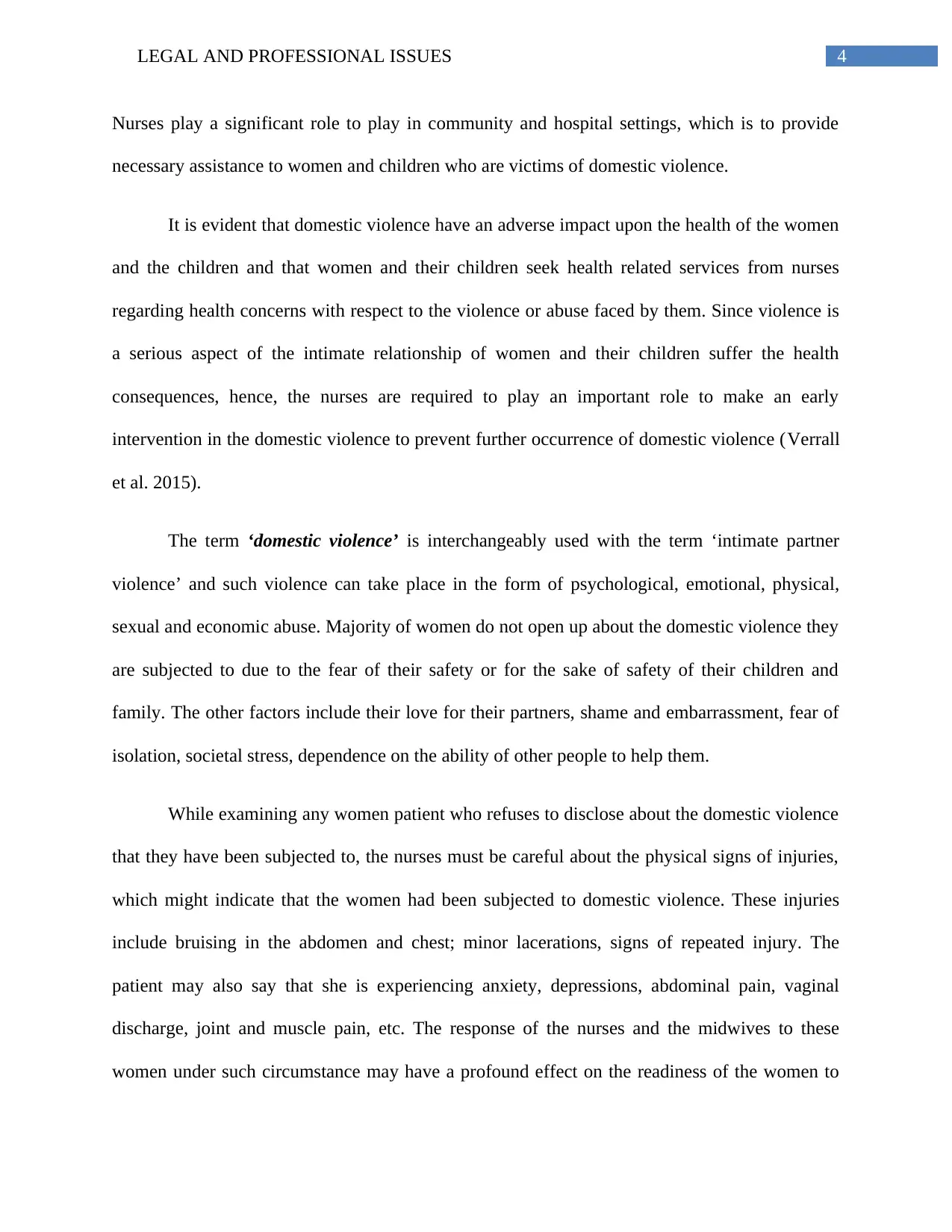
4LEGAL AND PROFESSIONAL ISSUES
Nurses play a significant role to play in community and hospital settings, which is to provide
necessary assistance to women and children who are victims of domestic violence.
It is evident that domestic violence have an adverse impact upon the health of the women
and the children and that women and their children seek health related services from nurses
regarding health concerns with respect to the violence or abuse faced by them. Since violence is
a serious aspect of the intimate relationship of women and their children suffer the health
consequences, hence, the nurses are required to play an important role to make an early
intervention in the domestic violence to prevent further occurrence of domestic violence (Verrall
et al. 2015).
The term ‘domestic violence’ is interchangeably used with the term ‘intimate partner
violence’ and such violence can take place in the form of psychological, emotional, physical,
sexual and economic abuse. Majority of women do not open up about the domestic violence they
are subjected to due to the fear of their safety or for the sake of safety of their children and
family. The other factors include their love for their partners, shame and embarrassment, fear of
isolation, societal stress, dependence on the ability of other people to help them.
While examining any women patient who refuses to disclose about the domestic violence
that they have been subjected to, the nurses must be careful about the physical signs of injuries,
which might indicate that the women had been subjected to domestic violence. These injuries
include bruising in the abdomen and chest; minor lacerations, signs of repeated injury. The
patient may also say that she is experiencing anxiety, depressions, abdominal pain, vaginal
discharge, joint and muscle pain, etc. The response of the nurses and the midwives to these
women under such circumstance may have a profound effect on the readiness of the women to
Nurses play a significant role to play in community and hospital settings, which is to provide
necessary assistance to women and children who are victims of domestic violence.
It is evident that domestic violence have an adverse impact upon the health of the women
and the children and that women and their children seek health related services from nurses
regarding health concerns with respect to the violence or abuse faced by them. Since violence is
a serious aspect of the intimate relationship of women and their children suffer the health
consequences, hence, the nurses are required to play an important role to make an early
intervention in the domestic violence to prevent further occurrence of domestic violence (Verrall
et al. 2015).
The term ‘domestic violence’ is interchangeably used with the term ‘intimate partner
violence’ and such violence can take place in the form of psychological, emotional, physical,
sexual and economic abuse. Majority of women do not open up about the domestic violence they
are subjected to due to the fear of their safety or for the sake of safety of their children and
family. The other factors include their love for their partners, shame and embarrassment, fear of
isolation, societal stress, dependence on the ability of other people to help them.
While examining any women patient who refuses to disclose about the domestic violence
that they have been subjected to, the nurses must be careful about the physical signs of injuries,
which might indicate that the women had been subjected to domestic violence. These injuries
include bruising in the abdomen and chest; minor lacerations, signs of repeated injury. The
patient may also say that she is experiencing anxiety, depressions, abdominal pain, vaginal
discharge, joint and muscle pain, etc. The response of the nurses and the midwives to these
women under such circumstance may have a profound effect on the readiness of the women to

5LEGAL AND PROFESSIONAL ISSUES
talk about the domestic violence that she is subjected to by her partner or any other family
member (Verrall et al. 2015)..
Under such circumstances, the nurses and the midwives must patiently listen to them and
support her assuring that she does not deserve this kind of behavior. They must emphasize on the
fact that such domestic violence is completely unacceptable. According to the Australian
Nursing and Midwifery Federation, domestic violence is considered as a criminal conduct that
damages the psychological and physical health, future and well-being of the victims. The nurses
and the midwives are required to be provided with adequate trainings regarding domestic
violence and the ways of dealing with the patients who have been subjected to domestic
violence.
An empowerment intervention model is necessary under such circumstances that would
focus mainly on the fundamental need for preventing domestic violence and ensuring safety and
protection of the victim of domestic violence. Such intervention includes legal intervention,
medical interventions that not only prevents further occurrence of domestic violence but also
aims at addressing the ethical and cultural issues that arises from the circumstances. They must
engage themselves. The nurses and the midwives are required to be engaged in development and
implementation of protocols and policies that develops strategies for people suffering from
domestic violence (Foureur et al. 2013). In order to ensure safety of the women and her children,
the nurses and midwives must converse with them separately about whether they need a safety
place to reside; whether she requires future safety, etc. It is important to make an emergency plan
regarding the safety of the women and her children.
talk about the domestic violence that she is subjected to by her partner or any other family
member (Verrall et al. 2015)..
Under such circumstances, the nurses and the midwives must patiently listen to them and
support her assuring that she does not deserve this kind of behavior. They must emphasize on the
fact that such domestic violence is completely unacceptable. According to the Australian
Nursing and Midwifery Federation, domestic violence is considered as a criminal conduct that
damages the psychological and physical health, future and well-being of the victims. The nurses
and the midwives are required to be provided with adequate trainings regarding domestic
violence and the ways of dealing with the patients who have been subjected to domestic
violence.
An empowerment intervention model is necessary under such circumstances that would
focus mainly on the fundamental need for preventing domestic violence and ensuring safety and
protection of the victim of domestic violence. Such intervention includes legal intervention,
medical interventions that not only prevents further occurrence of domestic violence but also
aims at addressing the ethical and cultural issues that arises from the circumstances. They must
engage themselves. The nurses and the midwives are required to be engaged in development and
implementation of protocols and policies that develops strategies for people suffering from
domestic violence (Foureur et al. 2013). In order to ensure safety of the women and her children,
the nurses and midwives must converse with them separately about whether they need a safety
place to reside; whether she requires future safety, etc. It is important to make an emergency plan
regarding the safety of the women and her children.
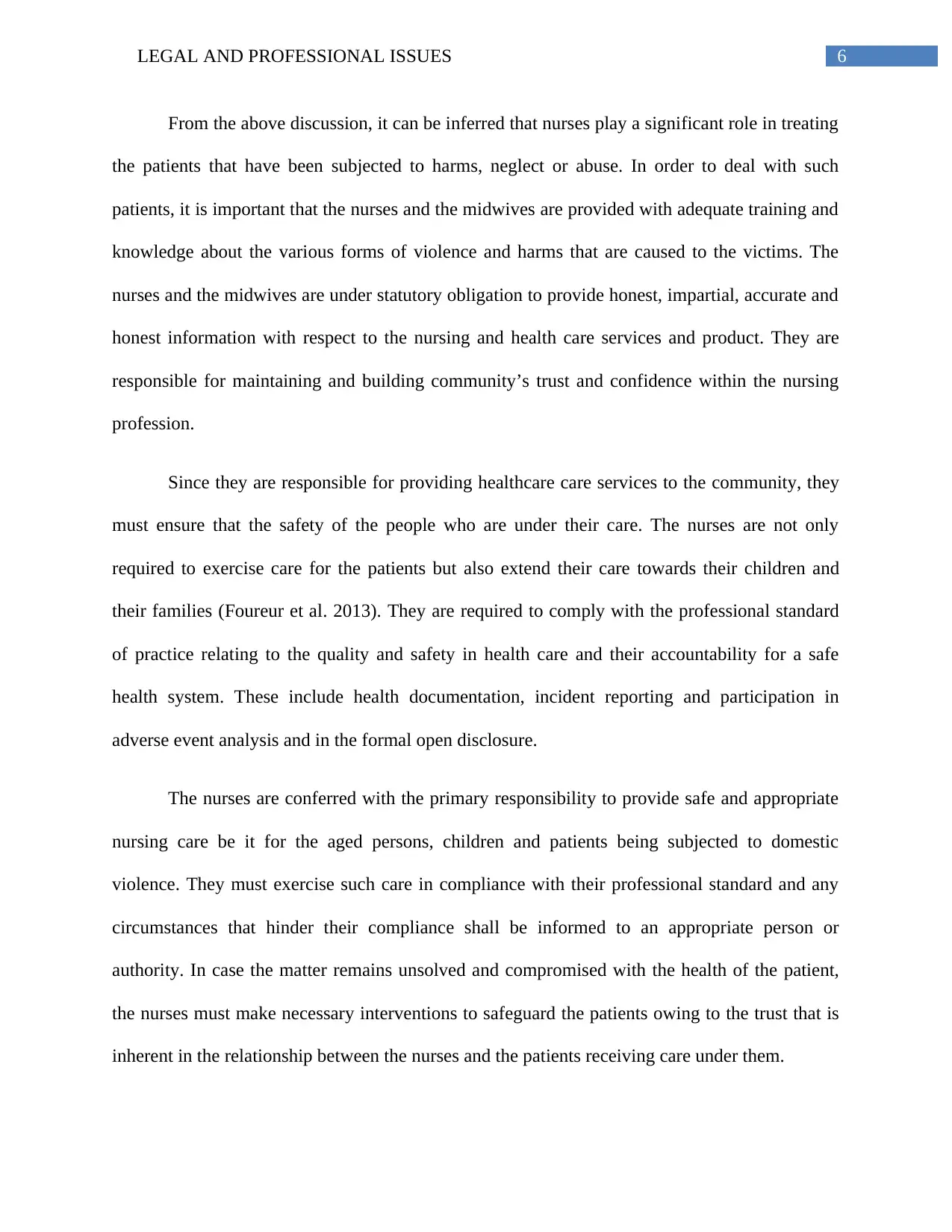
6LEGAL AND PROFESSIONAL ISSUES
From the above discussion, it can be inferred that nurses play a significant role in treating
the patients that have been subjected to harms, neglect or abuse. In order to deal with such
patients, it is important that the nurses and the midwives are provided with adequate training and
knowledge about the various forms of violence and harms that are caused to the victims. The
nurses and the midwives are under statutory obligation to provide honest, impartial, accurate and
honest information with respect to the nursing and health care services and product. They are
responsible for maintaining and building community’s trust and confidence within the nursing
profession.
Since they are responsible for providing healthcare care services to the community, they
must ensure that the safety of the people who are under their care. The nurses are not only
required to exercise care for the patients but also extend their care towards their children and
their families (Foureur et al. 2013). They are required to comply with the professional standard
of practice relating to the quality and safety in health care and their accountability for a safe
health system. These include health documentation, incident reporting and participation in
adverse event analysis and in the formal open disclosure.
The nurses are conferred with the primary responsibility to provide safe and appropriate
nursing care be it for the aged persons, children and patients being subjected to domestic
violence. They must exercise such care in compliance with their professional standard and any
circumstances that hinder their compliance shall be informed to an appropriate person or
authority. In case the matter remains unsolved and compromised with the health of the patient,
the nurses must make necessary interventions to safeguard the patients owing to the trust that is
inherent in the relationship between the nurses and the patients receiving care under them.
From the above discussion, it can be inferred that nurses play a significant role in treating
the patients that have been subjected to harms, neglect or abuse. In order to deal with such
patients, it is important that the nurses and the midwives are provided with adequate training and
knowledge about the various forms of violence and harms that are caused to the victims. The
nurses and the midwives are under statutory obligation to provide honest, impartial, accurate and
honest information with respect to the nursing and health care services and product. They are
responsible for maintaining and building community’s trust and confidence within the nursing
profession.
Since they are responsible for providing healthcare care services to the community, they
must ensure that the safety of the people who are under their care. The nurses are not only
required to exercise care for the patients but also extend their care towards their children and
their families (Foureur et al. 2013). They are required to comply with the professional standard
of practice relating to the quality and safety in health care and their accountability for a safe
health system. These include health documentation, incident reporting and participation in
adverse event analysis and in the formal open disclosure.
The nurses are conferred with the primary responsibility to provide safe and appropriate
nursing care be it for the aged persons, children and patients being subjected to domestic
violence. They must exercise such care in compliance with their professional standard and any
circumstances that hinder their compliance shall be informed to an appropriate person or
authority. In case the matter remains unsolved and compromised with the health of the patient,
the nurses must make necessary interventions to safeguard the patients owing to the trust that is
inherent in the relationship between the nurses and the patients receiving care under them.
Paraphrase This Document
Need a fresh take? Get an instant paraphrase of this document with our AI Paraphraser
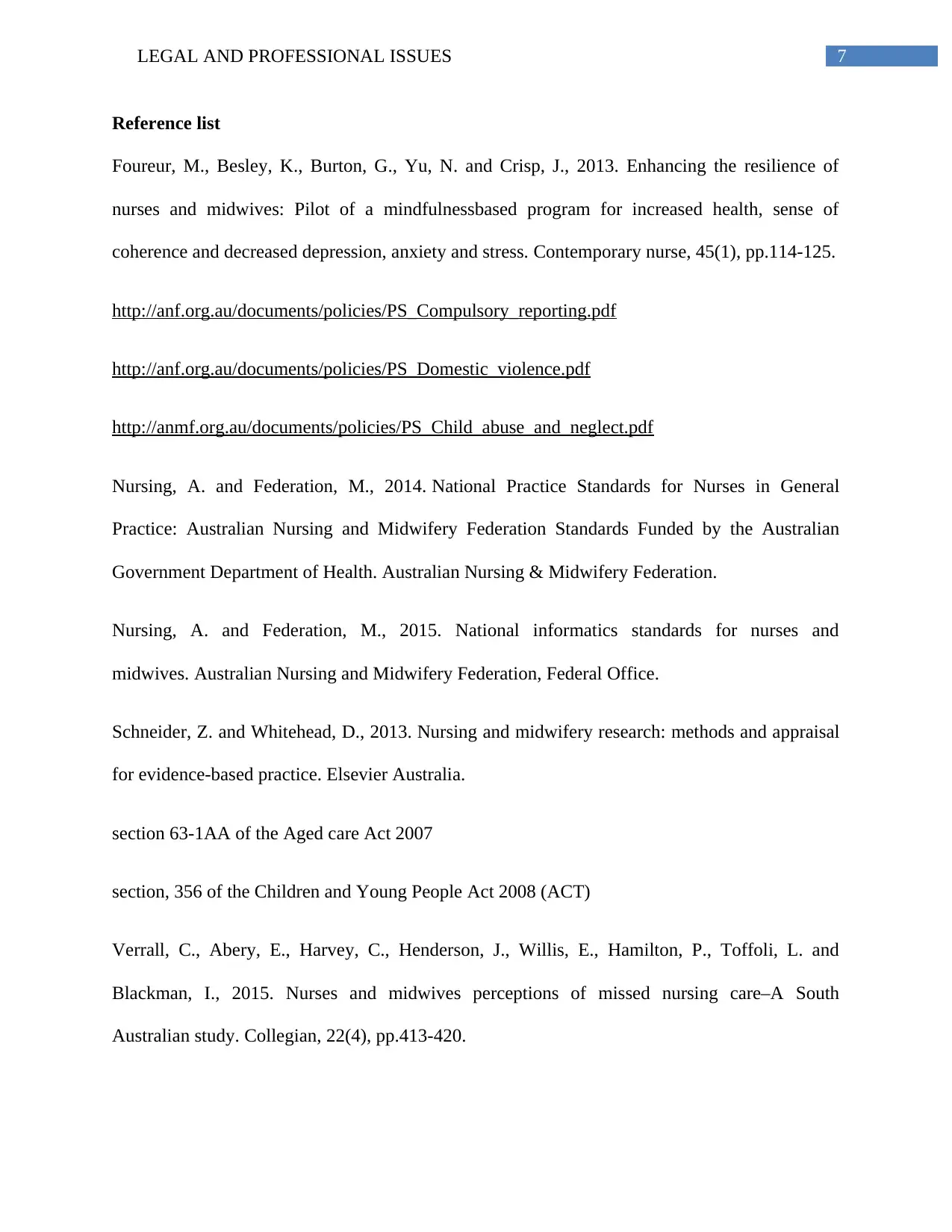
7LEGAL AND PROFESSIONAL ISSUES
Reference list
Foureur, M., Besley, K., Burton, G., Yu, N. and Crisp, J., 2013. Enhancing the resilience of
nurses and midwives: Pilot of a mindfulnessbased program for increased health, sense of
coherence and decreased depression, anxiety and stress. Contemporary nurse, 45(1), pp.114-125.
http://anf.org.au/documents/policies/PS_Compulsory_reporting.pdf
http://anf.org.au/documents/policies/PS_Domestic_violence.pdf
http://anmf.org.au/documents/policies/PS_Child_abuse_and_neglect.pdf
Nursing, A. and Federation, M., 2014. National Practice Standards for Nurses in General
Practice: Australian Nursing and Midwifery Federation Standards Funded by the Australian
Government Department of Health. Australian Nursing & Midwifery Federation.
Nursing, A. and Federation, M., 2015. National informatics standards for nurses and
midwives. Australian Nursing and Midwifery Federation, Federal Office.
Schneider, Z. and Whitehead, D., 2013. Nursing and midwifery research: methods and appraisal
for evidence-based practice. Elsevier Australia.
section 63-1AA of the Aged care Act 2007
section, 356 of the Children and Young People Act 2008 (ACT)
Verrall, C., Abery, E., Harvey, C., Henderson, J., Willis, E., Hamilton, P., Toffoli, L. and
Blackman, I., 2015. Nurses and midwives perceptions of missed nursing care–A South
Australian study. Collegian, 22(4), pp.413-420.
Reference list
Foureur, M., Besley, K., Burton, G., Yu, N. and Crisp, J., 2013. Enhancing the resilience of
nurses and midwives: Pilot of a mindfulnessbased program for increased health, sense of
coherence and decreased depression, anxiety and stress. Contemporary nurse, 45(1), pp.114-125.
http://anf.org.au/documents/policies/PS_Compulsory_reporting.pdf
http://anf.org.au/documents/policies/PS_Domestic_violence.pdf
http://anmf.org.au/documents/policies/PS_Child_abuse_and_neglect.pdf
Nursing, A. and Federation, M., 2014. National Practice Standards for Nurses in General
Practice: Australian Nursing and Midwifery Federation Standards Funded by the Australian
Government Department of Health. Australian Nursing & Midwifery Federation.
Nursing, A. and Federation, M., 2015. National informatics standards for nurses and
midwives. Australian Nursing and Midwifery Federation, Federal Office.
Schneider, Z. and Whitehead, D., 2013. Nursing and midwifery research: methods and appraisal
for evidence-based practice. Elsevier Australia.
section 63-1AA of the Aged care Act 2007
section, 356 of the Children and Young People Act 2008 (ACT)
Verrall, C., Abery, E., Harvey, C., Henderson, J., Willis, E., Hamilton, P., Toffoli, L. and
Blackman, I., 2015. Nurses and midwives perceptions of missed nursing care–A South
Australian study. Collegian, 22(4), pp.413-420.

8LEGAL AND PROFESSIONAL ISSUES
1 out of 9
Related Documents
Your All-in-One AI-Powered Toolkit for Academic Success.
+13062052269
info@desklib.com
Available 24*7 on WhatsApp / Email
![[object Object]](/_next/static/media/star-bottom.7253800d.svg)
Unlock your academic potential
© 2024 | Zucol Services PVT LTD | All rights reserved.





